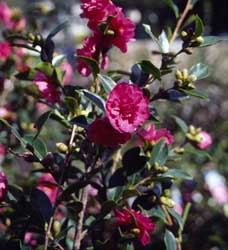Camellias
 Camellia
Camellia
Family Theaceae
Approximately 80 species; and thousands of named cultivars.
Used as an ornamental shrubbery plant, a topiary, hedge, or tub plant. They will grow surrounded by lawn or paving; and can even be espaliered. Both C. sasanqua and C. japonica can be trained as a hedge. C. sinensis, the source of commercial tea, can be grown in tropical areas as a crop, or as an ornamental.
Camellias are mainly evergreen shrubs (some small trees); leaves simple, toothed margins, alternate, thick, leathery and usually with showy flowers.
The optimum temperature for most is 10-20 degrees C.
Camellia sasanqua has smaller flowers, but is more adaptable than others species. C. sasanqua will tolerate full sun and sub tropical areas better than many others. C. japonica has been bred widely to produce thousands of different flowering forms. C. japonica is best grown in temperate climates. C. reticulata cultivars are generally more upright, with more open foliage and very large flowers, but not in the same quantity as the other two main types. C. sinensis, the source of commercial tea, can be grown in tropical areas as a crop, or as an ornamental.
Camellias are relatively hardy plants once established. They usually prefer a protected position, with light to semi shade. There are some exceptions though....
Even though most are hardy, some are not.
Even though most resist frost, a few do not.
Even though most tolerate damp spots some don't.
Although many will survive some dry spells once established, others don't.
Although most grow in infertile soils, some don't.
An acid, fertile, moist, but well drained soil. Light pruning can be done if necessary (after flowering) to keep in shape. They respond well to mulching with rotted manures or compost. Tea-leaves can also be spread as a mulch after being used for brewing tea.
They generally grow well in the shade of deciduous trees or amongst other woody shrubs of similar vigor.
Cuttings of selected varieties, or seed for mass plantings.
Generally problems are few if environmental conditions are suitable. Various pests may cause problems including aphis, thrip mealy bug, mites and scale. Root rots may develop in poorly drained places. Other diseases that can occasionally occur include leaf spots, leaf gall, leaf spot, flower blight, canker, leaf blight and viruses.
Most camellias are normally propagated by cuttings.
Seed grown plants do have the disadvantage of not always being the same as their parent: there can great be variation in the flower when propagated this way. Seedlings can be grafted onto. This is done occasionally in commercial production.
When propagated by cuttings; the new plant will always have exactly the same as what the parent plant was, in every respect for this reason, these techniques are generally preferable to seed.
Cultivars
There are three main groups of cultivars, each having been bred and developed from a different species. Flower colour and height are highly variable across the many thousands of cultivars that fall within these three groups.
Camellia japonica is the largest of these three groups, with dark green glossy leaves and single or double flowers. Most commonly grown cultivars are well suited to climates such as Melbourne and Sydney but can be grown from Queensland to Tasmania.
Camellia sasanqua has smaller flowers than japonicas, and a slightly lighter green coloured foliage. They are generally more adaptable to warmer or more humid climates; but will also grow across a wide range of climates. Compared with japonicas, they tolerate sun better, and cold less.
Camellia reticulata ‑these are larger plants (up to 18m tall although rare) with very large flowers (can be over 20cm diameter). They tend to be less tolerant of cold than japonicas, but due to their size, are often unsuited to smaller gardens.
Some other species grown include:
Camellia saluensis -to 5m tall.
Camellia sinensis ‑commercial tea plant, highly variable according to cultivar, 1-10m tall, suited to tropics and sub tropics.
Camellia cuspidata ‑narrow leaves, relatively hardy shrub, to 4.5m tall.
Camellia fraterna ‑low growing shrub, to 4m tall.
Camellia oleifera ‑oil from this is used commercially in china.
Camellia pitardii ‑used in hybridizing reticulatas.
Camellia irrawadiensis ‑vigorous, small but numerous cream/white flowers, to 6m tall.